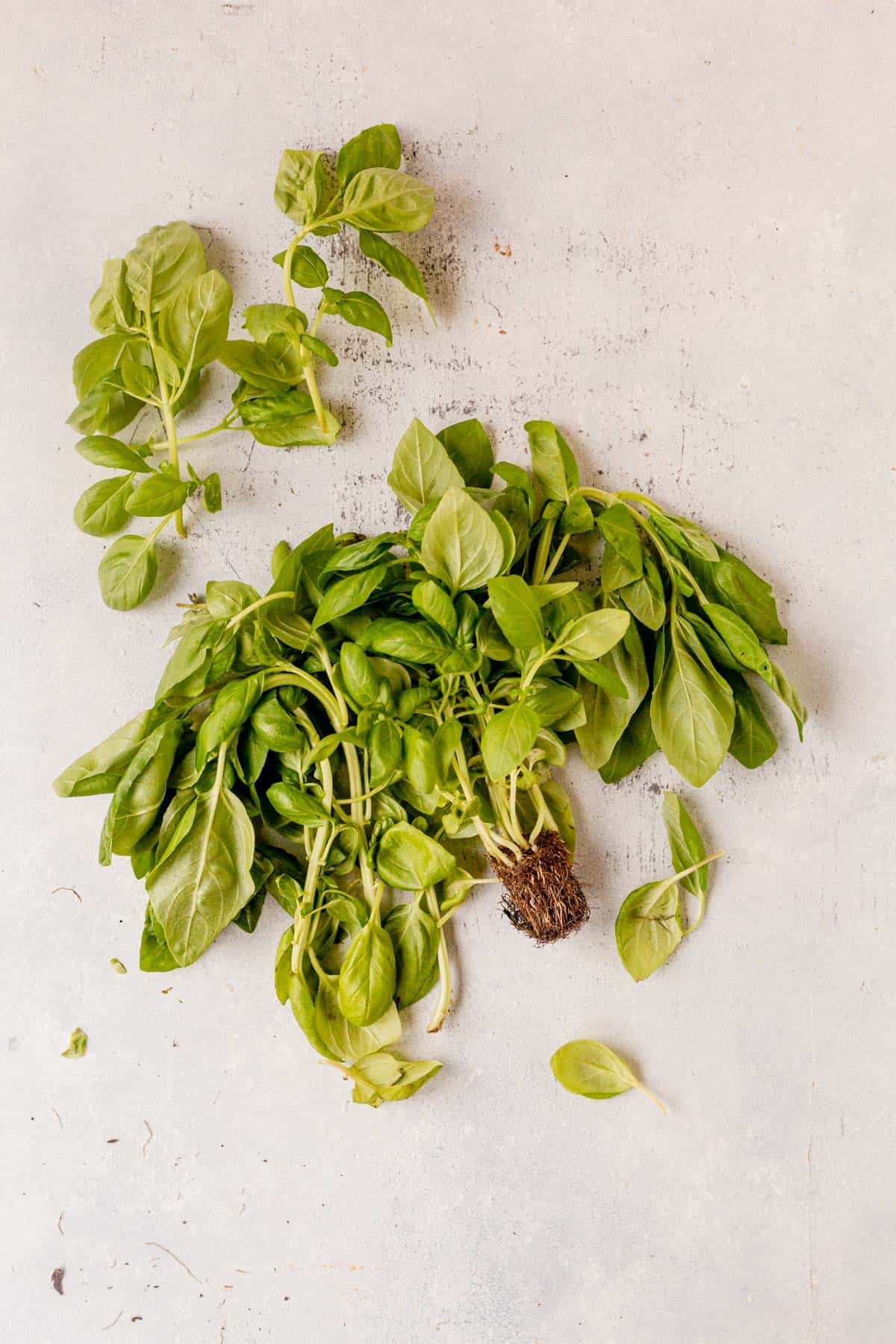This post may contain affiliate links. Read our disclosure policy.
Learn how to freeze basil so you minimize food waste and always have some on hand for your favorite recipes. Here are two simple ways!
Looking for more basil recipes? Try burrata pasta, asparagus frittata, or Italian meatball soup.

If you have lots of fresh basil plants that are growing really well or your grocery store had basil on sale, being able to freeze it will have you enjoying it’s fresh flavor all year long.
Some of our favorite recipes using basil are this Instant Pot Corn Chowder with Bacon or these Strawberry Basil Popsicles. We also love adding it to this Healthy Fruit Salsa!
If you have other plants in your garden also doing really well, be sure to check out some of our other resources that show you great ways to Freeze Kale or How to Cut Green Onions!
Freezing Basil
In the summer months, if you’re lucky enough, your garden basil plants will be overflowing! You don’t want it to go bad so can freeze it to preserve the flavor.
Basil is a fairly delicate herb with a mild sweet flavor, making it great for pasta sauces and salad dressings, like this Easy Fresh Herb Vinaigrette or Basil Vinaigrette for our Grilled Peach Salad. However, if the basil is not preserved properly, the flavor that whole basil leaves provide can diminish.
In general, freezing your basil is the best way to preserve its fresh flavor.
Should you dry basil instead? Dry basil can often have a slightly different flavor profile than frozen fresh basil leaves so we recommend freezing.

How to Freeze Basil – 2 Ways
Freezing fresh basil leaves is a simple process that helps to preserve its freshness while simultaneously keeping its flavor for several months. Here are two of our favorite ways (with and without the blanching process).
Method 1: Freeze Fresh Basil into Ice Cubes with Oil
Freezing basil in oil is my favorite way too freeze basil. Basil is thinner, with more fragile leaves, so they’re well suited for being chopped and frozen in oil.
Wash & dry basil leaves: Using a paper towel or a salad spinner will expedite the drying process.

Slice: gently slice or julienne the basil leaves. Divide your sliced basil among ice cube tray sections (no blanching needed!).
Expert tip: Try using silicone ice cube trays for easy removal!

Add oil: Fill the ice cube tray with oil until you cover leaves. You could also use water or broth.

Freeze: freeze thebasil cubes until firm, about 2 hours.

Transfer to a bag: Place frozen basil cubes in labeled zip-top freezer bags or freezer-safe containers.
How to use froa zen basil: Grab 1-2 cubes and place them into your dish towards the end of cooking to melt, as desired.

Method 2: Freeze Blanched Basil
Blanching is the process of scalding vegetables in boiling water or steam for a short time. It is then followed by a quick and thorough cooling in very cold water or ice water. Blanching stops enzyme actions which otherwise cause loss of flavor, color and texture.
Note: You can freeze raw basil, but it may have a slightly different flavor profile than blanched basil.
- Wash & dry basil leaves. We recommend drying your basil leaves using a paper towel, clean kitchen towel, or salad spinner. Both, a paper towel and a salad spinner, will assist in expediting the drying process.
- Blanch. Once your water is boiling, put your whole leaves into the boiling water for roughly 30 seconds.
- Place blanched leaves in an ice bath. Transfer blanched leaves immediately to an ice water bath.
- Dry blanched leaves. Spin the blanched leaves dry using your salad spinner (or pat dry with a paper towel as best you can).
- Flash freeze. Lay out on a baking sheet or cookie sheet and freeze until firm.
- Transfer leaves to a freezer-safe container or zip-top freezer bag. Note: since the frozen leaves are thin, they will start thawing immediately, so move quickly.
It stay fresh for up to 6 months. If using a zip-top freezer bag, it’s important to squeeze as much air out of the bag as possible to avoid freezer burn.
Note: the texture and green color of basil may change slightly throughout the blanching process. This is a normal occurrence throughout the entire cooking process.
How to use: Use it directly in your favorite recipes or thaw overnight in the fridge.

Expert Tips
- Wash and dry basil really well before freezing. You can do so by blotting it with paper towels or using a salad spinner.
- Freeze while it’s at its peak freshness.
How to Freeze Basil Pesto
Basil pesto is one of our favorite things to add to not only pasta dishes, like our Salmon Pesto Pasta, but also salads, like our Orzo Salad, on side dishes, like these Crispy Roasted Pesto Potatoes, or in our Easy Pesto Chicken.
To freeze basil pesto, you must first make your pesto. Using pine nuts, fresh basil, garlic cloves, and a few other ingredients, you can make this amazing and easy Basil Pesto that takes only 10 minutes to make. Great news – it’s vegan, too! You will need a food processor to make this basil pesto.
Once your pesto is made, transfer the mixture to ice cube trays and be careful not to overfill. Freeze for 3-5 hours, or until the cubes will easily pop out (silicone ice cube trays make for easy removal!). Transfer the cubes to a zip-top freezer bag, label, and put in freezer for up to six months. These frozen basil pesto cubes are especially great for spaghetti sauce!

Frequently Asked Questions
You can freeze whole basil leaves! An easy way to freeze whole basil leave is to blanch them then flash freeze them on a baking sheet.
You don’t have to blanch basil before freezing if you’re in a hurry, but blanching helps preserve the flavor and color.
Blanching is the process of scalding vegetables in boiling water or steam for a short time. It is then followed by a quick and thorough cooling in very cold water or ice water.
Blanching stops enzyme actions which otherwise cause loss of flavor, color and texture.
You can dry it or freeze it, but freezing retains the fresh flavor better.

Favorite Recipes Using Basil
Here are some of our favorite recipes using fresh basil! Use up your fresh basil with these recipes before you freeze them or add the frozen basil to your favorite soups, sauces, and stews.
Note: frozen basil is best in soups and sauces rather than in fresh recipes like Caprese salad.
Basil Recipes Before Freezing
- Lemon Orzo Salad with Lemon Basil Vinaigrette
- Summer Orzo Salad with Basil Pesto
- Grilled Zucchini Salad
- Vegan Basil Pesto
- Quinoa Salad with Feta
- Peach Burrata Salad
Recipes to Use Up Frozen Basil
- Burrata Pasta with Burst Cherry Tomatoes
- Instant Pot Corn Chowder
- Italian Meatball Soup
- Instant Pot Lasagna Soup

If you try freezing your basil, I’d love for you to give it a star rating ★ below. You can also tag me on Instagram so I can see it!
How to Freeze Basil

Save this Recipe!
Ingredients
- Bunch of fresh basil
Instructions
- Wash & dry basil leaves. Using a paper towel or a salad spinner will expedite the drying process.
- Slice or julienne basil leaves. Basil is a delicate herb, so use a sharp knife so you don't damage the leaves when you slice it.
- Divide the sliced basil into a silicone ice cube tray section until it reaches the top, about 1 Tablespoon of fresh basil in each section. No need to blanch the basil. Add olive oil to cover the basil, about 1 Tablespoon.
- Freeze basil cubes until firm, about 2 hours. Transfer the frozen basil cubes into a labeled zip-top freezer bag or freezer-safe container.
Notes
Equipment
- Silicone Ice Cube Tray
Nutrition
Nutrition information is automatically calculated, so should only be used as an approximation.









